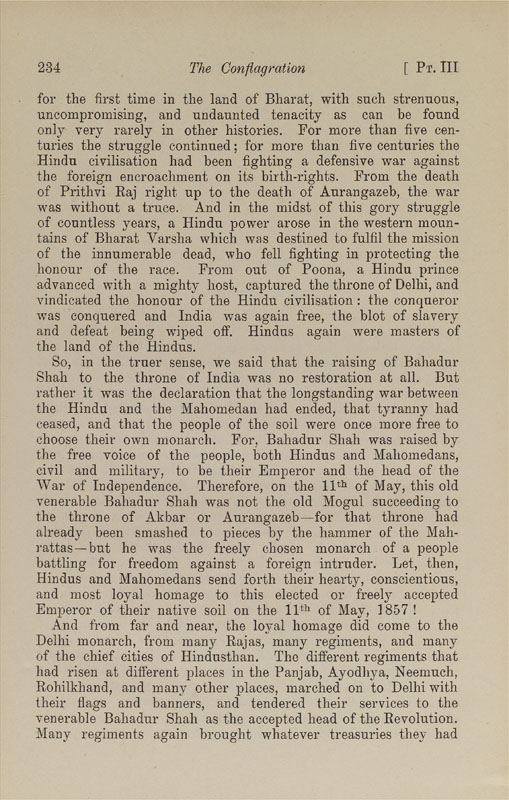234
The Conflagration
[ Pt. Ill
for the first time in the land of Bharat, with such strenuous,
uncompromising, and undaunted tenacity as can be found
only very rarely in other histories. For more than five cen¬
turies the struggle continued; for more than five centuries the
Hindu civilisation had been fighting a defensive war against
the foreign encroachment on its birth-rights. From the death
of Prithvi Raj right up to the death of Aurangazeb, the war
was without a truce. And in the midst of this gory struggle
of countless years, a Hindu power arose in the western moun¬
tains of Bharat Varsha which was destined to fulfil the mission
of the innumerable dead, who fell fighting in protecting the
honour of the race. From out of Poona, a Hindu prince
advanced with a mighty host, captured the throne of Delhi, and
vindicated the honour of the Hindu civilisation : the conqueror
was conquered and India was again free, the blot of slavery
and defeat being wiped off. Hindus again were masters of
the land of the Hindus.
So, in the truer sense, we said that the raising of Bahadur
Shah to the throne of India was no restoration at all. But
rather it was the declaration that the longstanding war between
the Hindu and the Mahomedan had ended, that tyranny had
ceased, and that the people of the soil were once more free to
choose their own monarch. For, Bahadur Shah was raised by
the free voice of the people, both Hindus and Mahomedans,
civil and military, to be their Emperor and the head of the
War of Independence. Therefore, on the 11*^ of May, this old
venerable Bahadur Shah was not the old Mogul succeeding to
the throne of Akbar or Aurangazeb—for that throne had
already been smashed to pieces by the hammer of the Mah¬
rattas—but he was the freely chosen monarch of a people
battling for freedom against a foreign intruder. Let, then,
Hindus and Mahomedans send forth their hearty, conscientious,
and most loyal homage to this elected or freety accepted
Emperor of their native soil on the 11*^ of May, 1857 !
And from far and near, the loyal homage did come to the
Delhi monarch, from many Rajas, many regiments, and many
of the chief cities of Hindusthan. The different regiments that
had risen at different places in the Panjab, Ayodhya, Neemuch,
Rohilkhand, and many other places, marched on to Delhi with
their flags and banners, and tendered their services to the
venerable Bahadur Shah as the accepted head of the Revolution.
Many regiments again brought whatever treasuries they had
I
|








